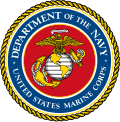| Marine Corps Installations Pacific (MCIPAC) | |
|---|---|
 | |
| Active | Sept. 1, 2011 - present |
| Allegiance | |
| Branch | |
| Type | Regional installation management |
| Role | Support to operating forces |
| Size | ~7,300 |
| Headquarters | Camp Foster |
| Nickname | MCIPAC |
| Anniversaries | Sept. 1, 2011. |
| Commanders | |
| Current commander | MajGen Brian N. Wolford |
The Marine Corps Installations Pacific (MCIPAC) is the single, regional authority for accountability of regional installation management resources and services within the Pacific area of operations. MCIPAC was established to increase regional installation management effectiveness. MCIPAC implements policies, develops regional strategies and plans, prioritizes resources, and provides services, direction, and oversight to all Marine Corps installations in Japan, the Republic of Korea, and Hawaii.
Contents
MCIPAC includes approximately 2,600 service members, 1,200 civilian employees, and more than 3,500 Japanese and Korean workers in the Pacific Region. Whether participating in operations or training exercises, MCIPAC supports units before, during, and after each deployment. The command is responsible for ensuring installations provide a number of services like training areas, work facilities, utilities and housing.
MCIPAC remains committed to enhancing operational readiness, from the individual service member to every echelon of the Marine Air Ground Task Force, while at the same time, cooperating, coordinating and communicating with our regional communities, partners, and allies. MCIPAC regularly engages in bilateral planning to ensure strong, long-term and mutually beneficial partnerships with our[ who? ] neighbors in the region. These continually developing relationships define MCIPAC's community relations effort.

